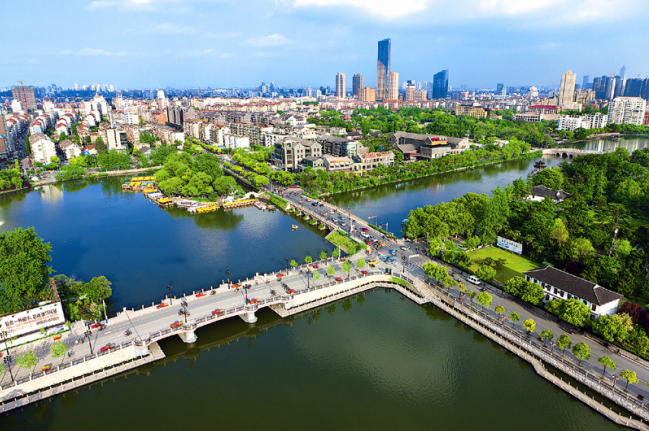Editor’s note: In 2014, Nantong in Jiangsu province made new social and economic progress. Nantong Report will introduce the achievements and update the changes regularly. In this edition, we look at the city’s environmental protection efforts.

Nantong has introduced measures to tackle air and river pollution as part of its environmental improvement efforts. [Provided to China Daily]
• In 2014, Nantong carried out programs to improve the environment in rural areas. And it has been constantly enhancing a long-term management system for the rural environment.
These efforts paid off. In April last year, the city passed the assessment by Jiangsu province’s department for environmental improvement. Nantong is the first prefecture-level city in Jiangsu to pass the provincial assessment.
Also, Kaisha village in Tongzhou and Guzhuang village in Rugao of Nantong were voted two of China’s most beautiful villages or towns in 2014. The nationwide voting began in 2013 and was supported by several central government departments including the Research Office of the State Council, the Ministry of Agriculture, and the National Tourism Administration.
• Last August, the Nantong government released a new policy for the environmental resources compliance audit of major government leaders. In September, the policy was put into practice in Hai’an of Nantong, which was the first place in the province to carry out such an audit.
The program was highly praised by the Ministry of Environmental Protection and the National Audit Office, as well as the Environmental Protection Department and the Audit Department of Jiangsu province.
• Nantong carried out a series of comprehensive measures to prevent and control air pollution.
A total of 49 coal-fired boilers of local thermal power plants were upgraded or reconstructed to meet higher emissions standards, and 126 small coal-fired boilers were abandoned or upgraded. Meanwhile, 45 key enterprises improved treatment of volatile organic compounds before disposal.
The city eliminated 190,000 heavy-polluting vehicles. It completed the upgrading projects of local oil storages, oil tank trucks, and gas stations for higher oil and gas recovery rates.
Special actions were carried out to deal with construction dust in the city. And the comprehensive utilization of crop straw was further promoted in the region to prevent the practice of burning straw.
Nantong’s air quality has improved consistently thanks to the measures.
From January to November of last year, the rate of its air quality meeting the target standards reached 72.3 percent, up 7 percent against that of 2013, and it ranked second among all the cities in Jiangsu province.
In 2014, the average concentration of PM2.5 in Nantong fell by 8.3 percent year-on-year, which was the sharpest drop among all cities in the province last year.
• In early 2014, Nantong built the world’s first complete pulping and papermaking device producing zero emissions in the tail water.
The equipment was designed by Xu Nanping, an academician with the Chinese Academy of Engineering, and an expert team from Nanjing University of Technology at the invitation of the Nantong Development Zone. A supportive technical team of more than 20 related experts in China also participated in the project.
The device can treat 40,000 tons of tail water daily. The quality of recovered water is higher than the standards for tap water. The device has, for the first time in the world, realized the industrial use of recycled water from pulping, and equates to a water-recycling plant added to the city.
It has become an innovative and demonstrative project for boosting the circular economy, energy conservation and emissions reduction as well as ecological protection.
President Xi Jinping inspected the project at the Jiangsu Industrial Technology Research Institute in December, and expressed his encouragement after learning about the program details, including its investment, technologies and effects.
• Since it launched a campaign to become a national ecological city in 2006, Nantong has put great emphasis on air pollution control, treatment of river pollution in key areas, the elimination of heavily polluting industries, and the ecological health of its chemical industrial park.
The city has developed a growth mode that integrates industries with urban development, and combines economic and social growth as well as the ecological environment.
In a provincial assessment for the ecological civilization construction in 2013, Nantong ranked third in Jiangsu province. Nantong’s Economic and Technological Development Zone was approved as a national eco-industrial park by the ministries of environmental protection, science and technology, and commerce.
After eight years of unremitting efforts, Nantong passed the assessment by the Ministry of Environmental Protection and became a national ecological city in December 2014.
This was recognition that the city has made significant achievements in its efforts toward becoming a first-class ecological city in China.
